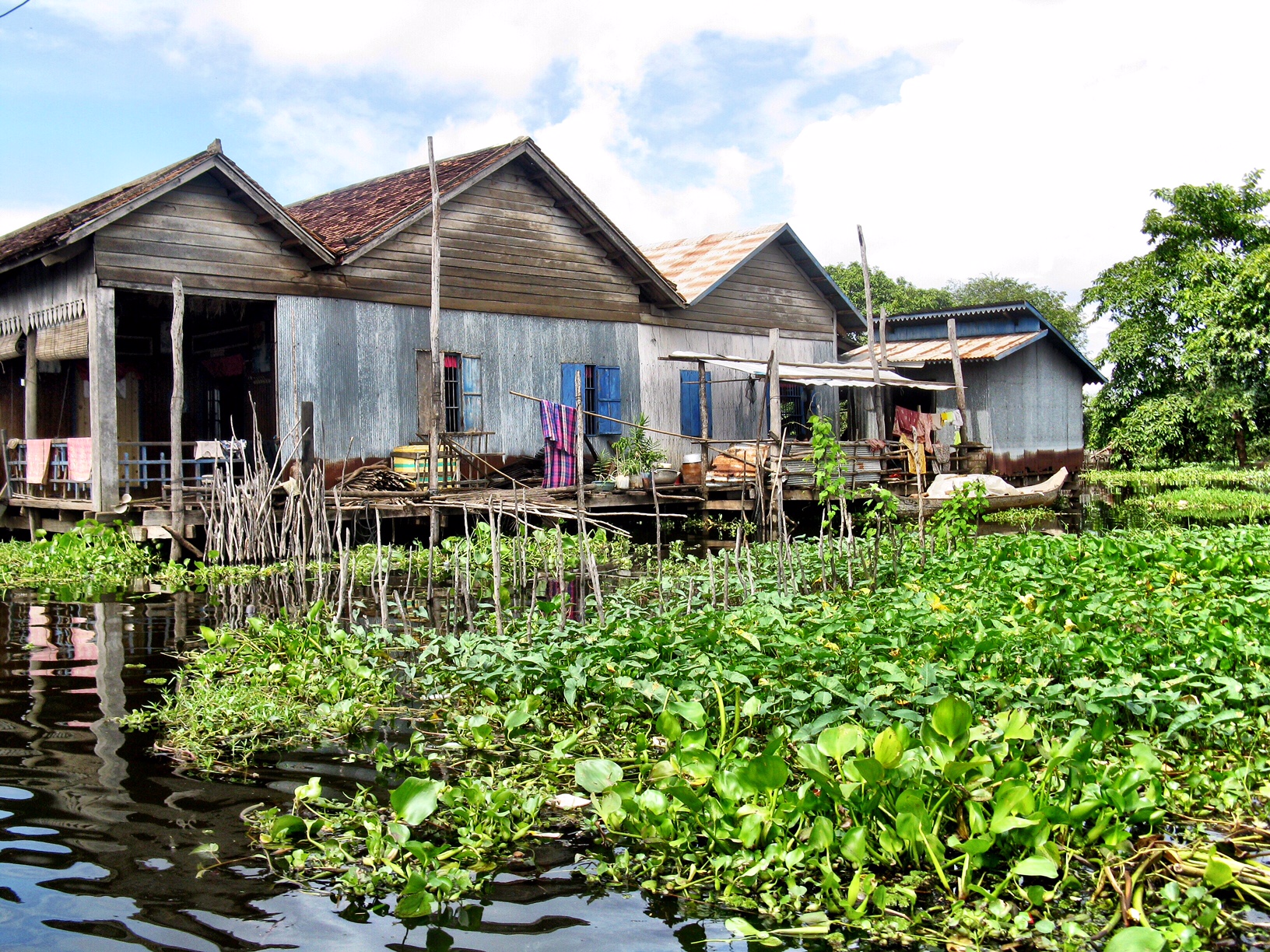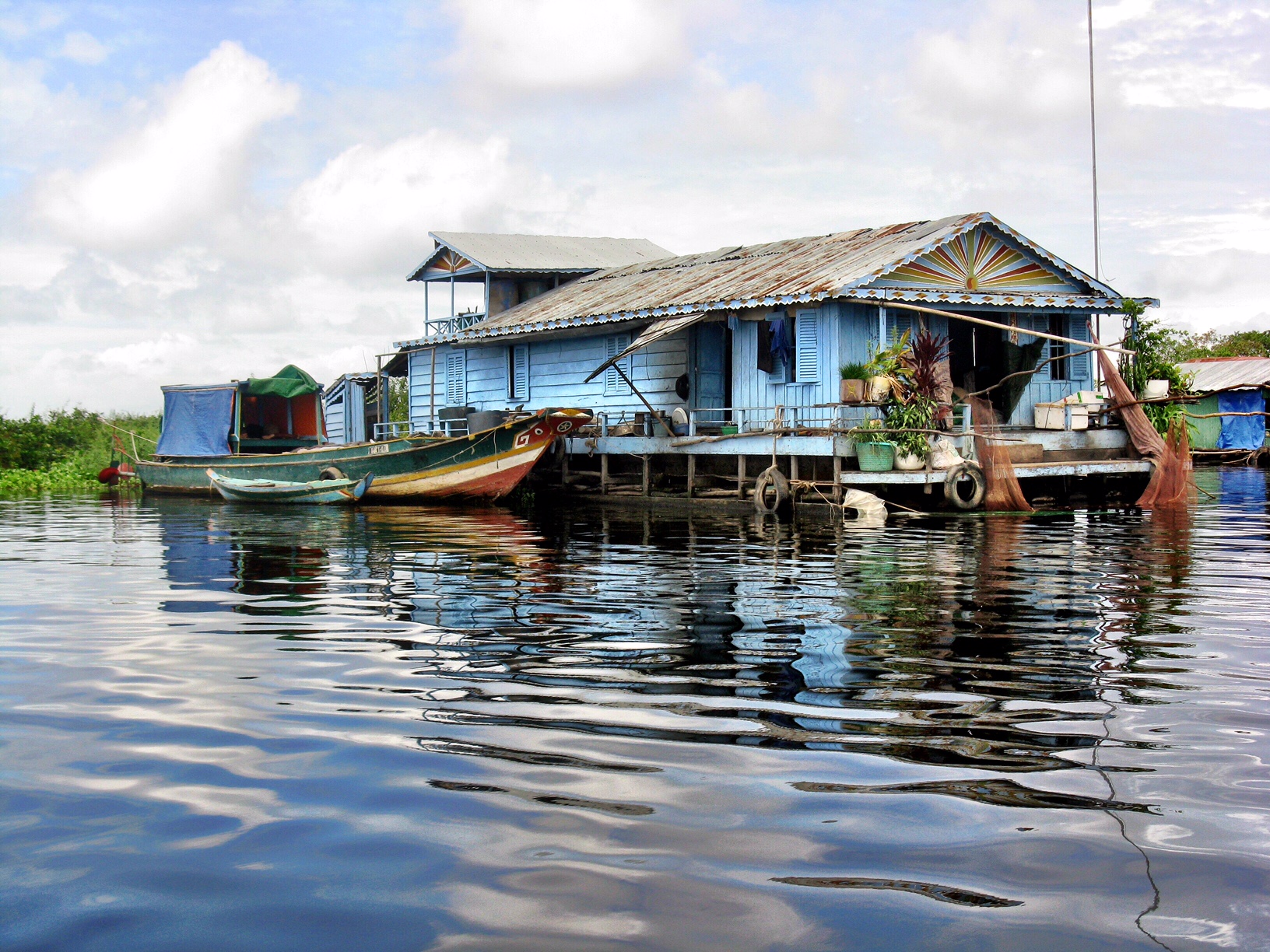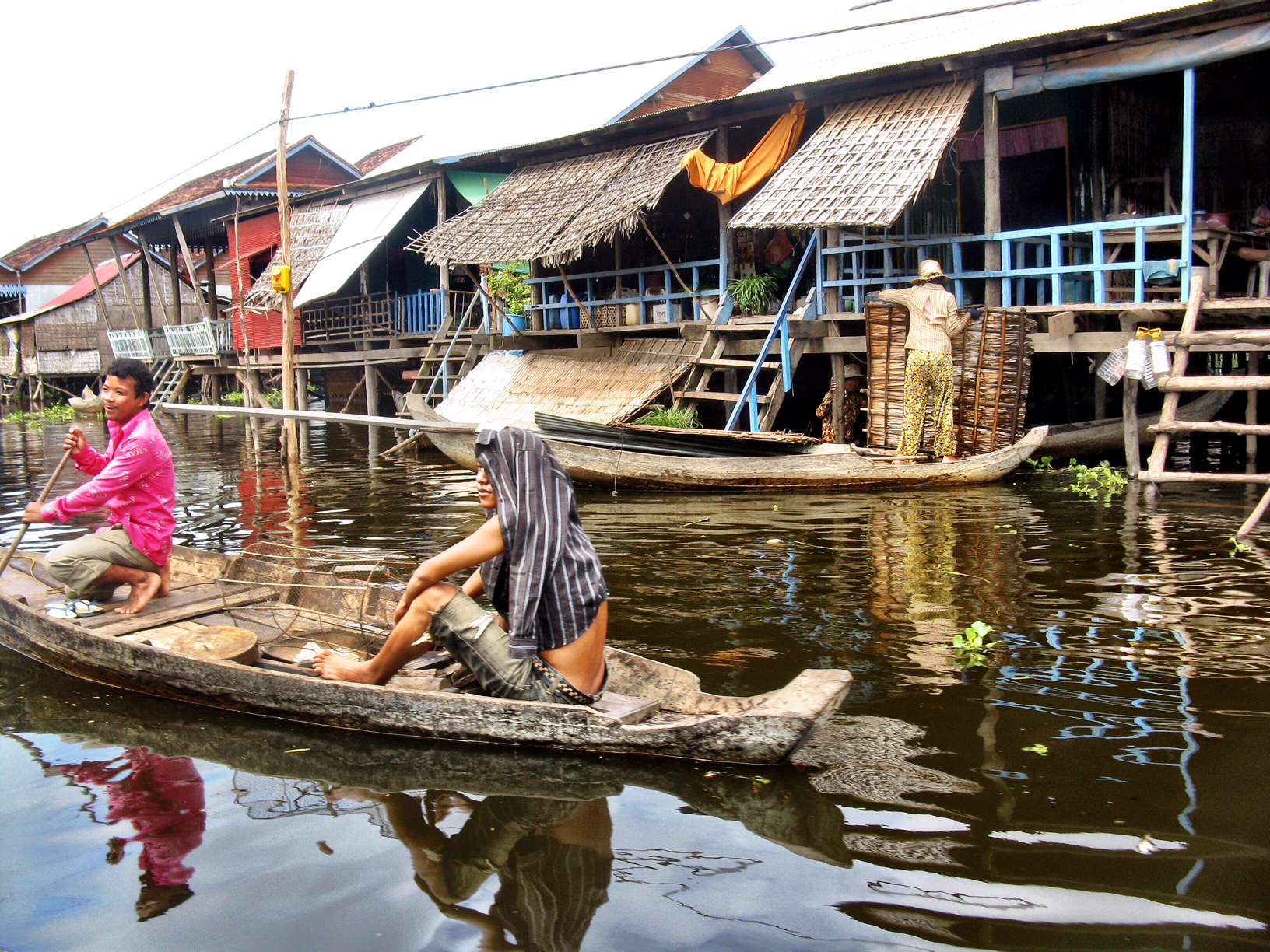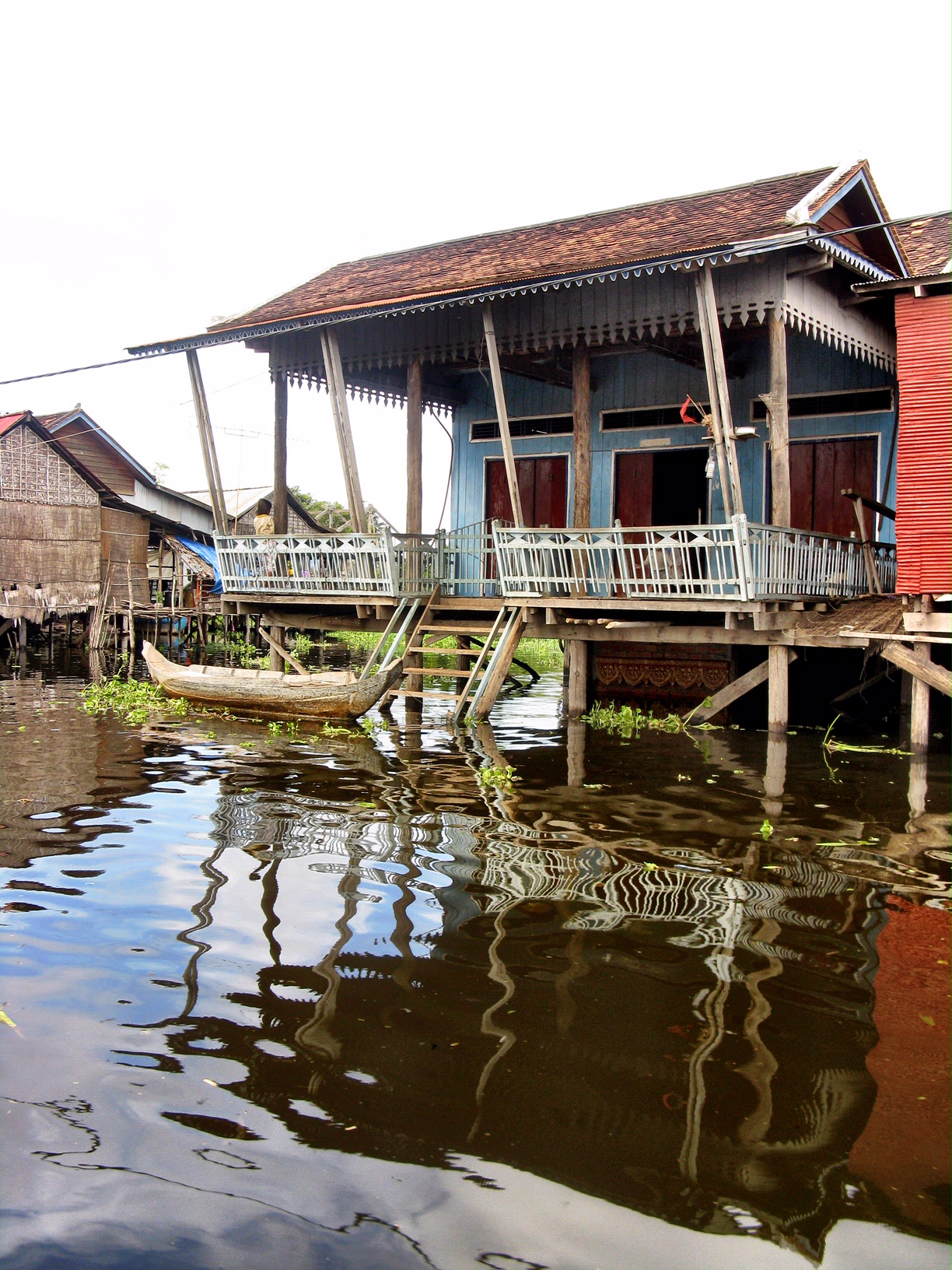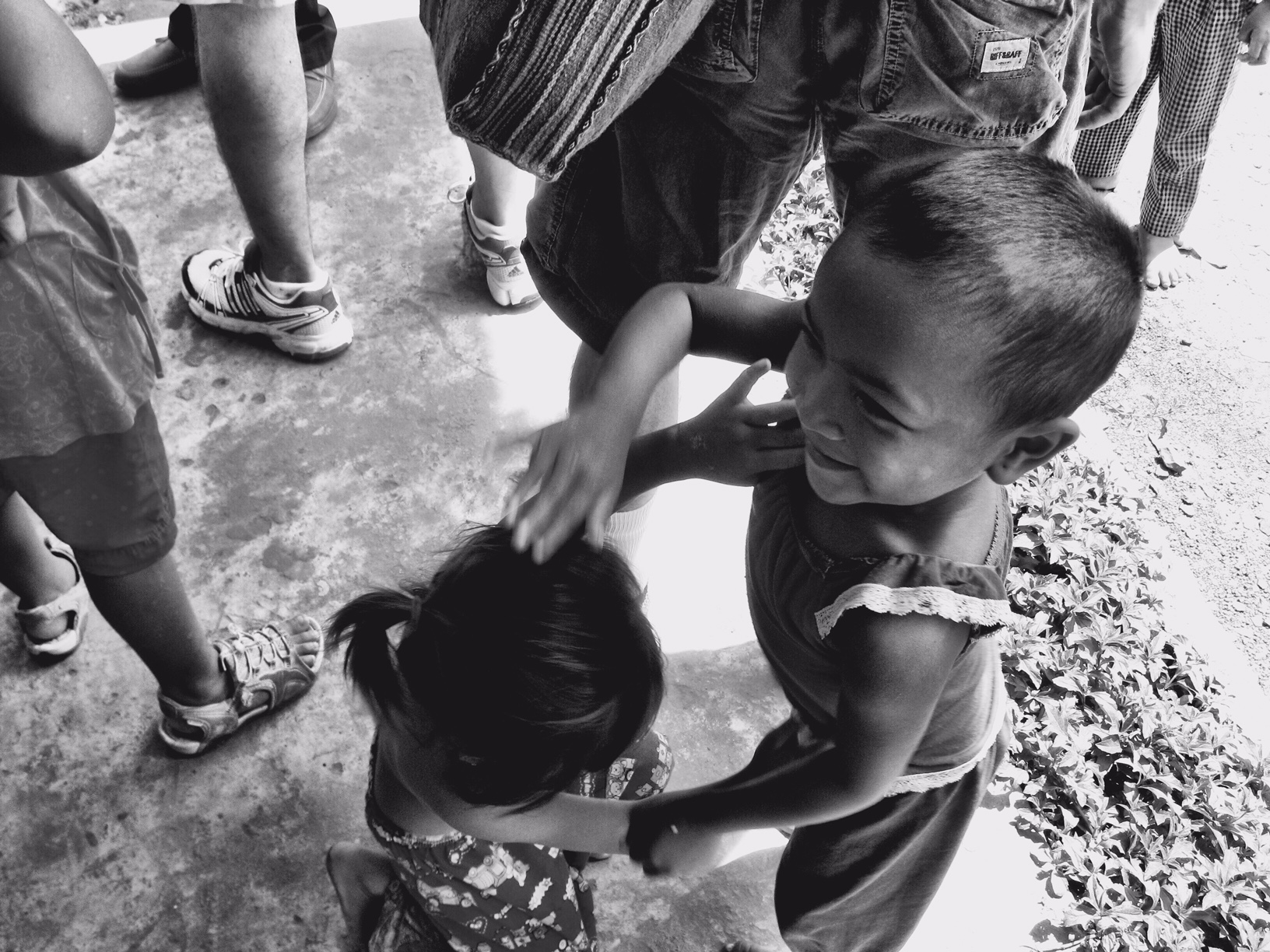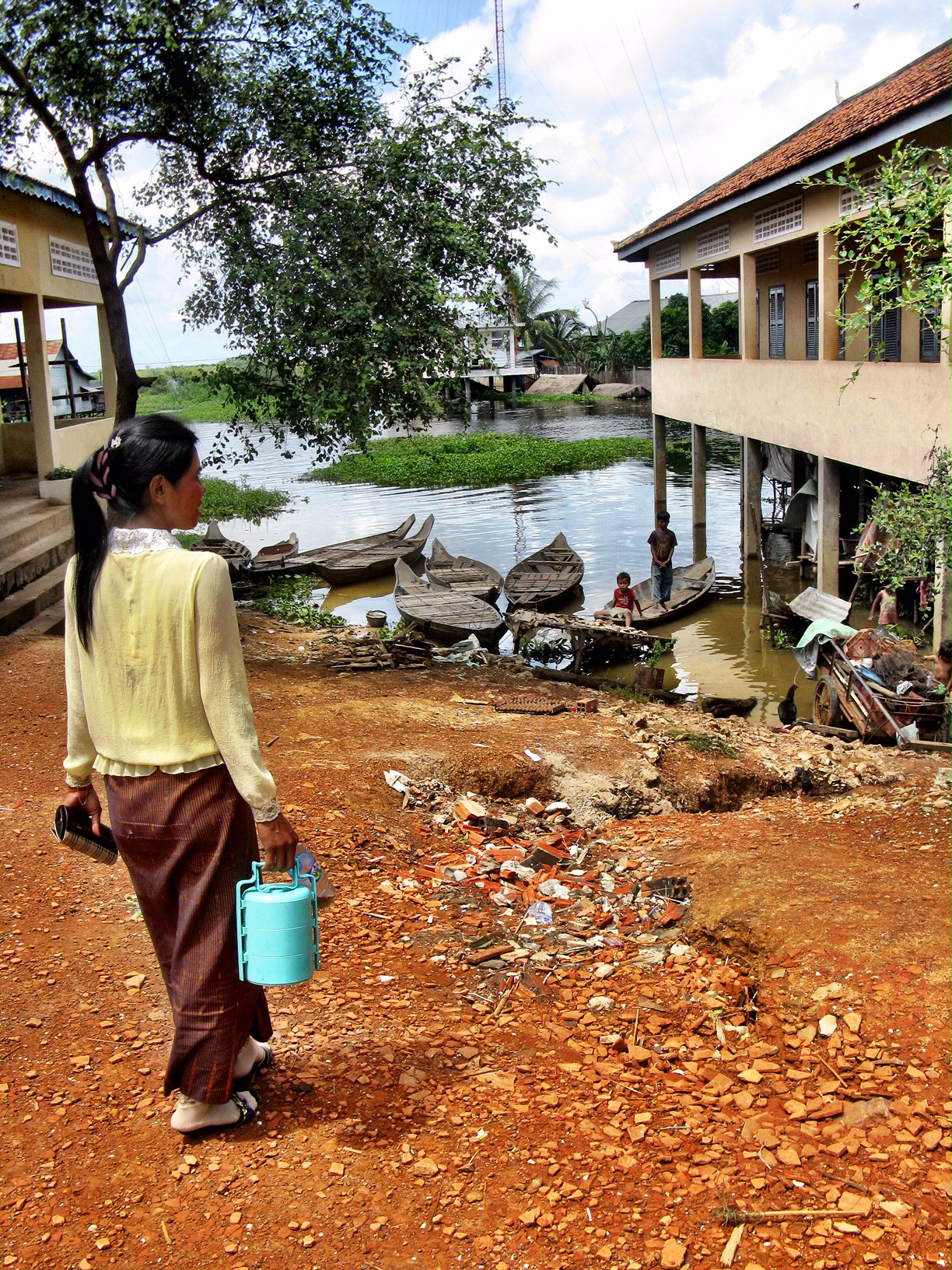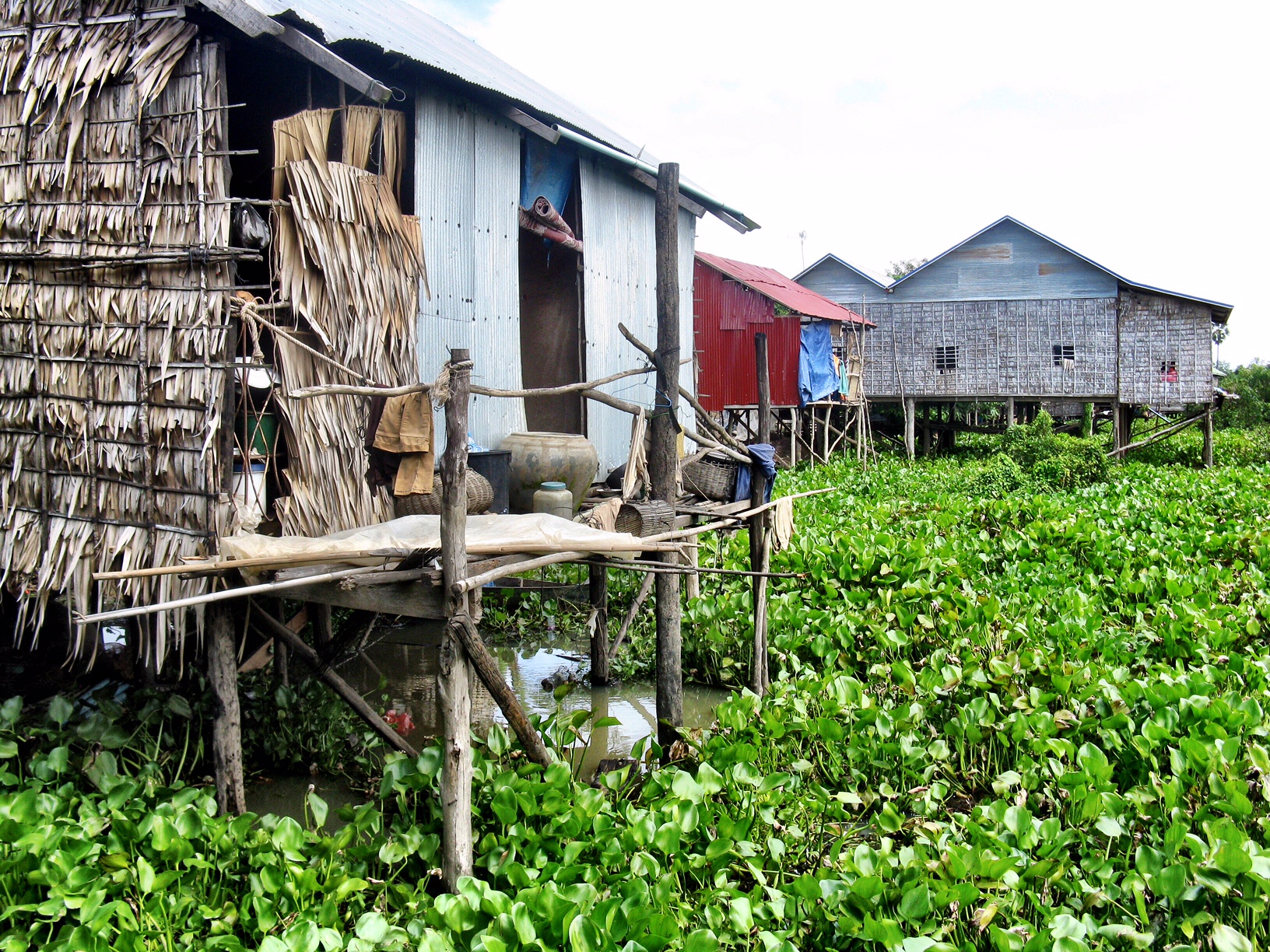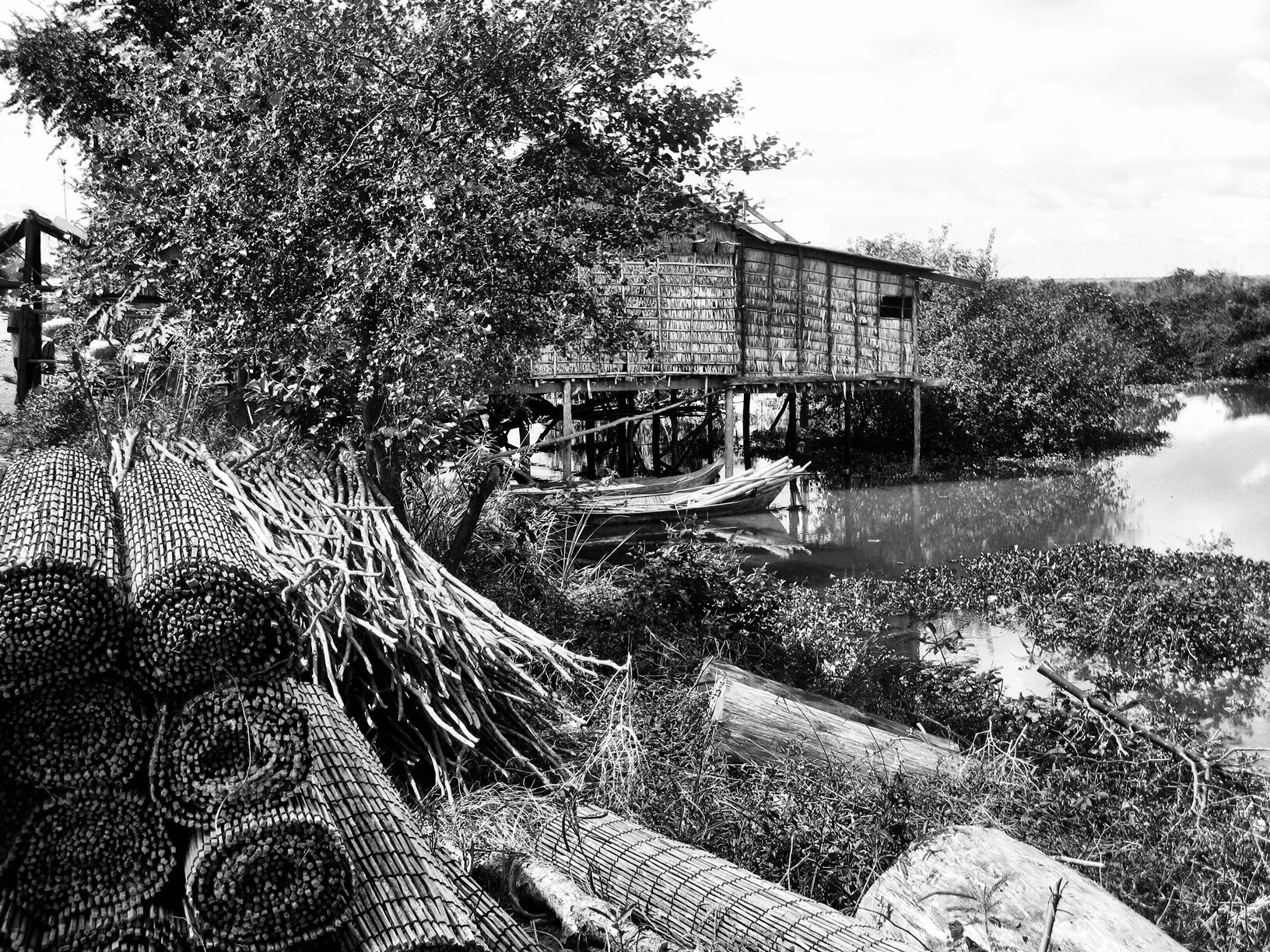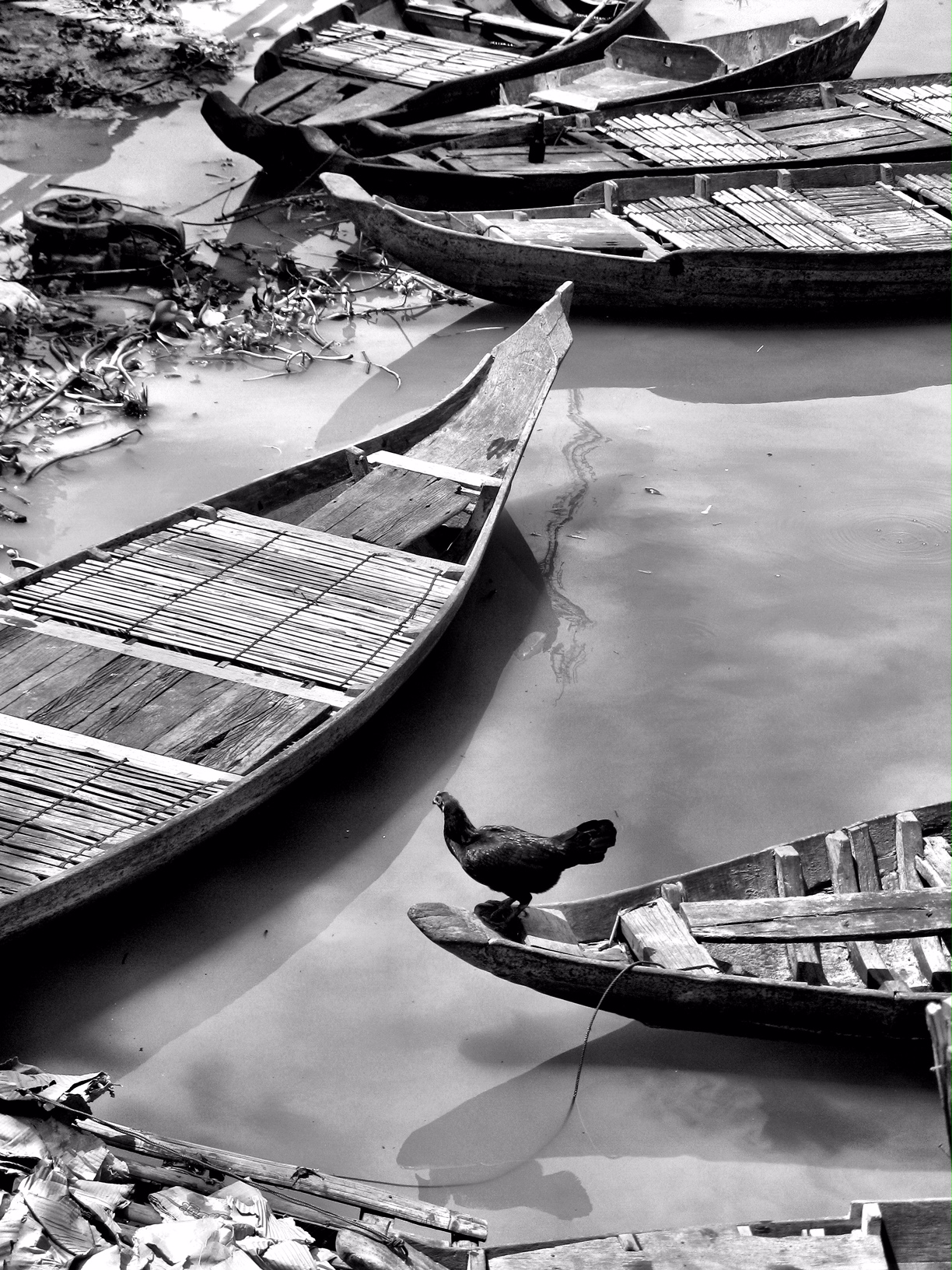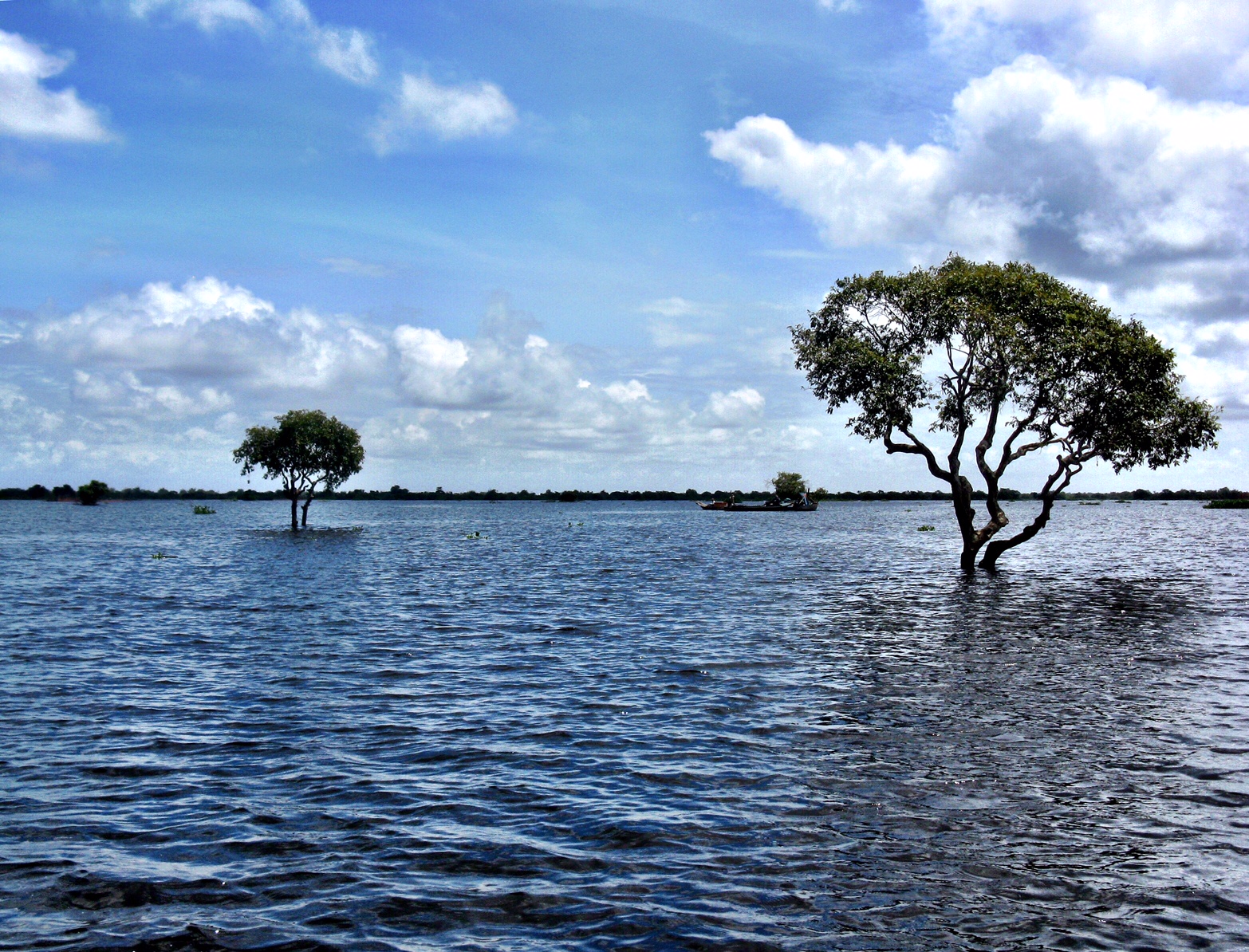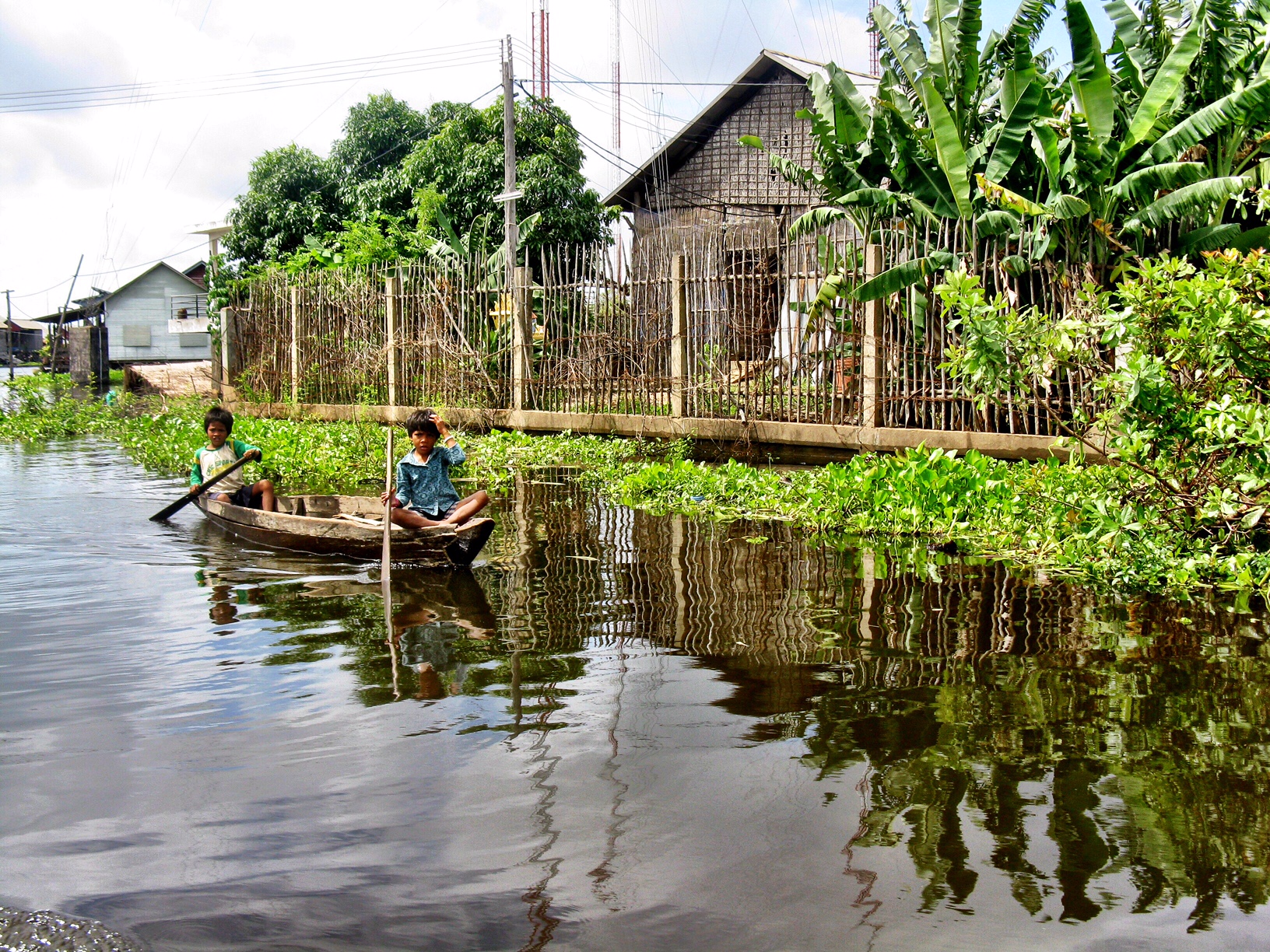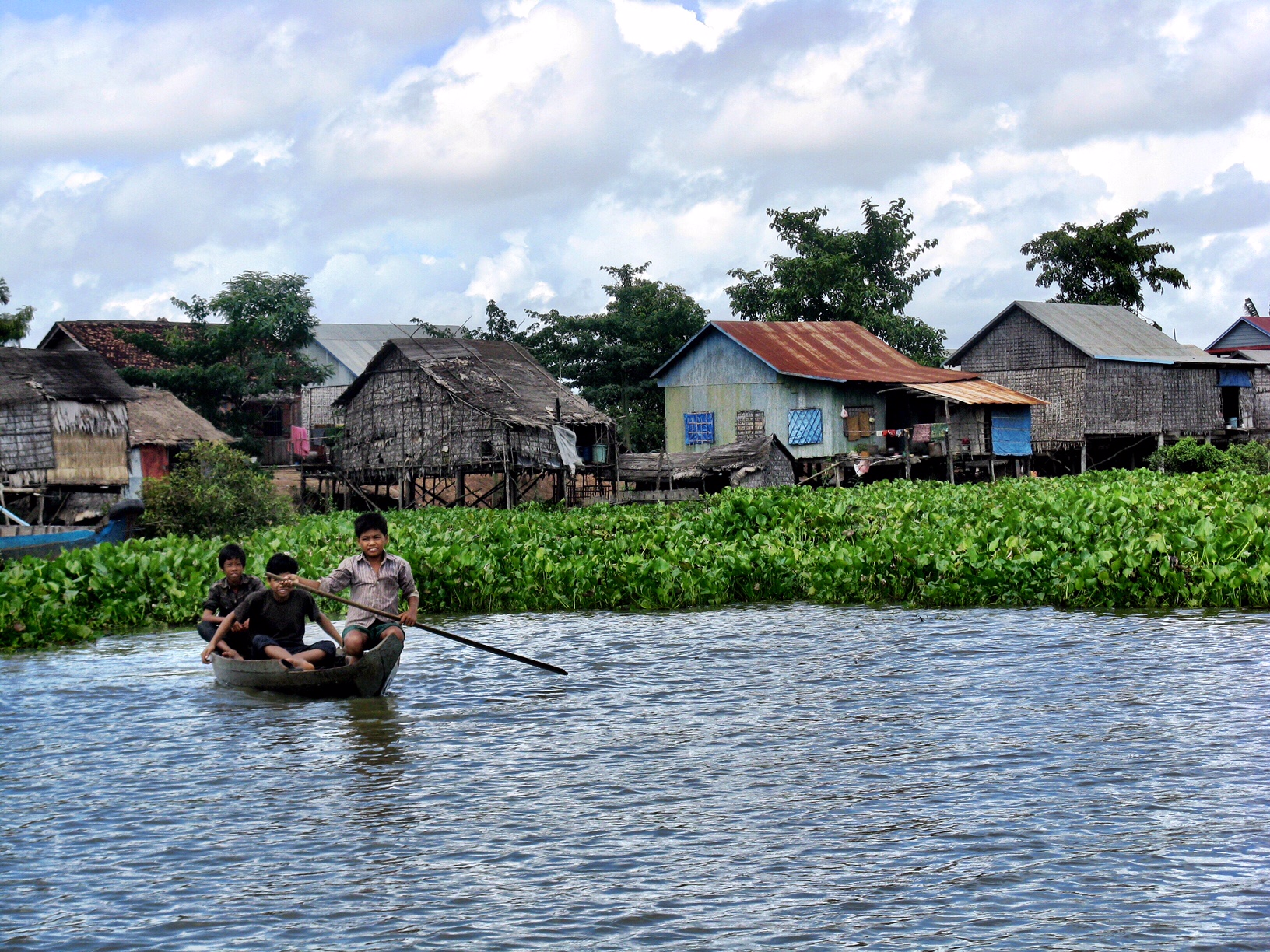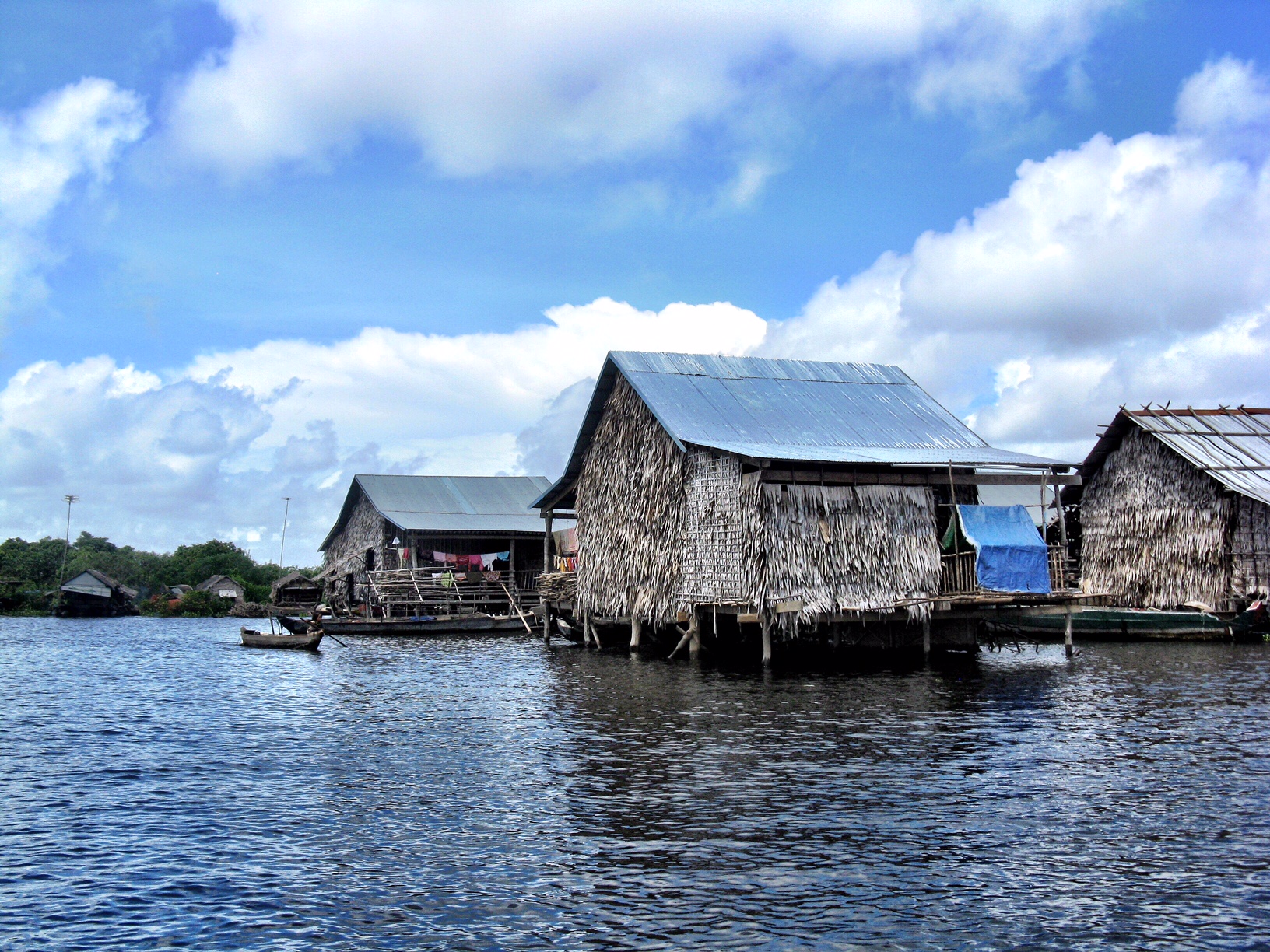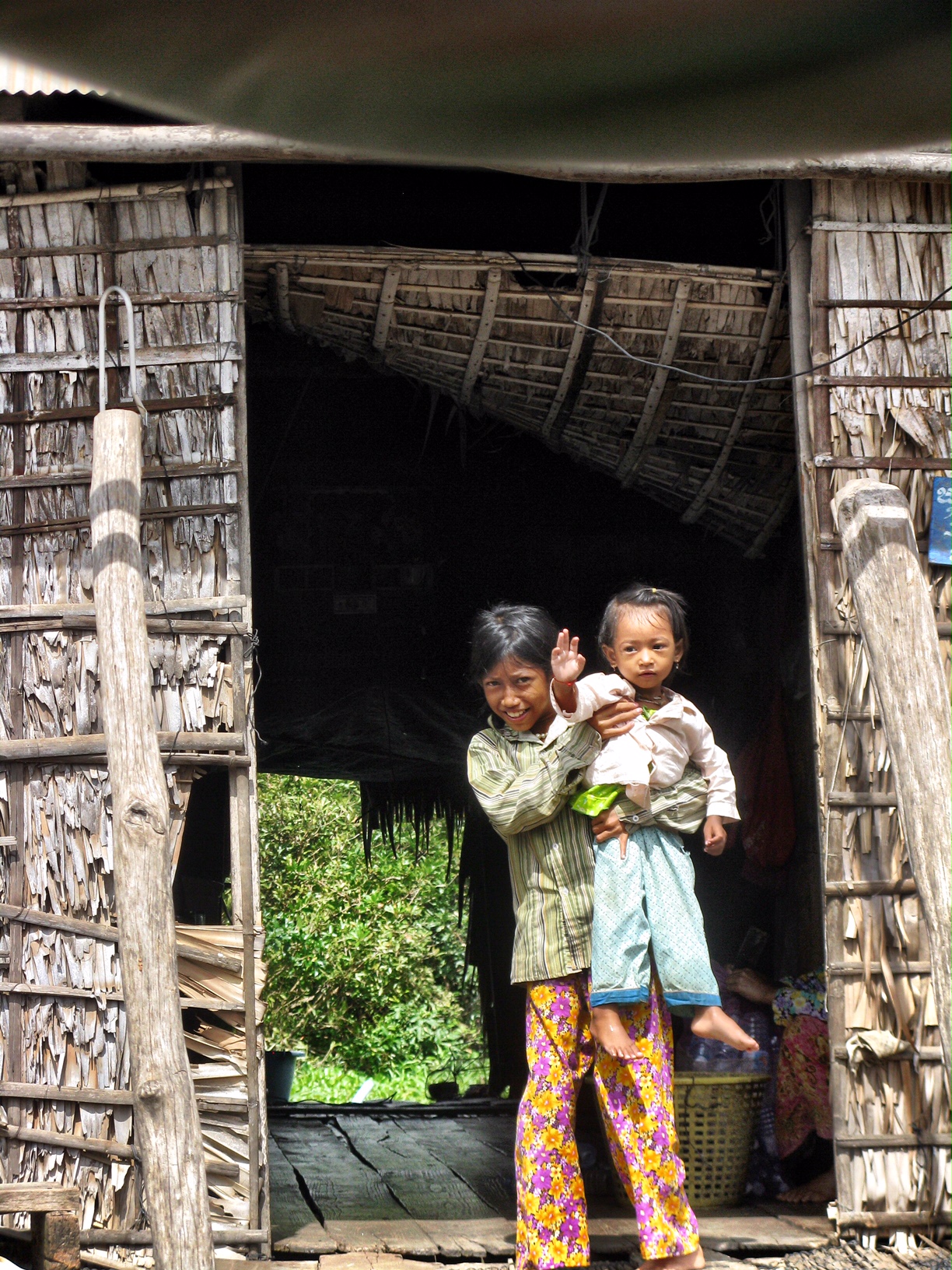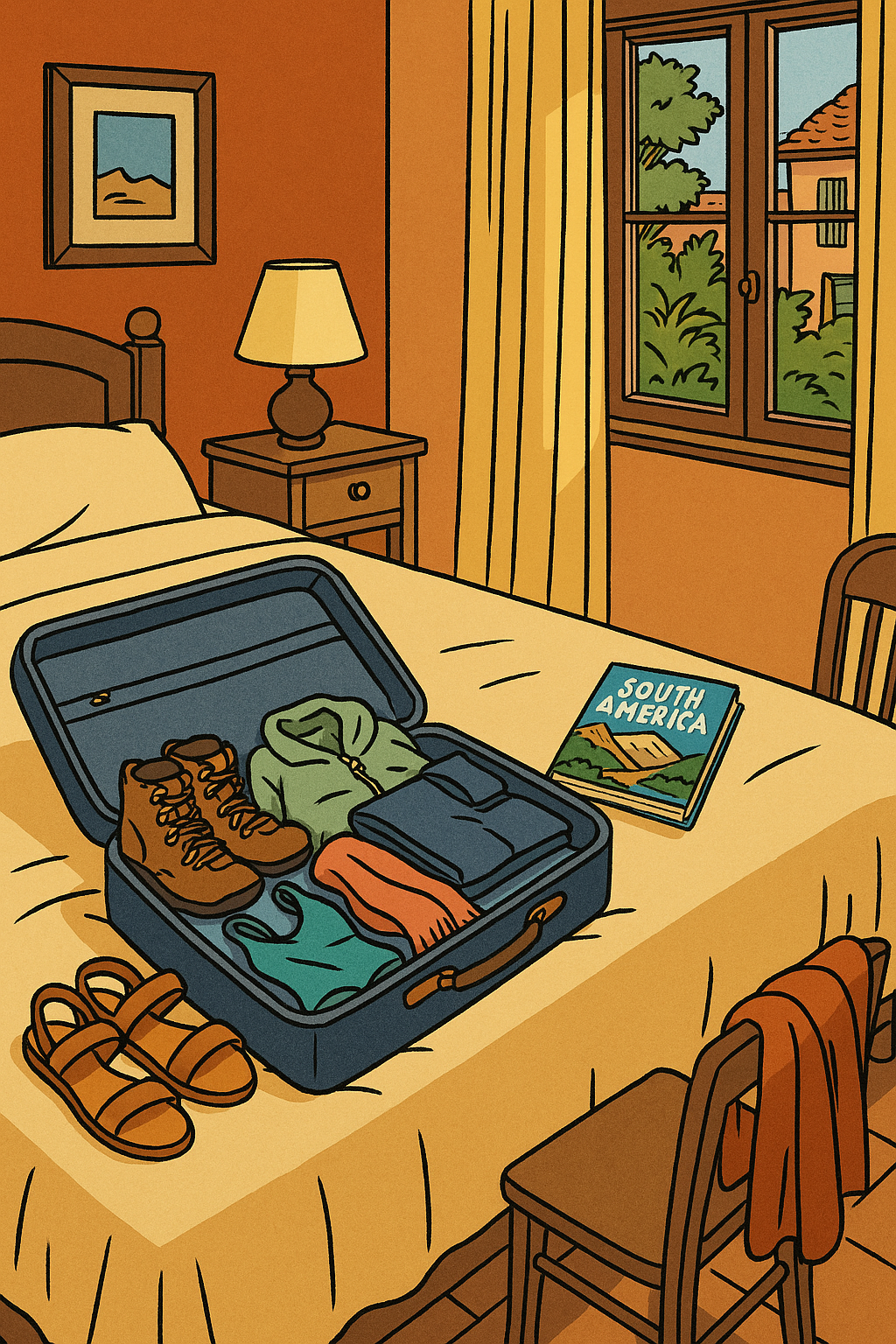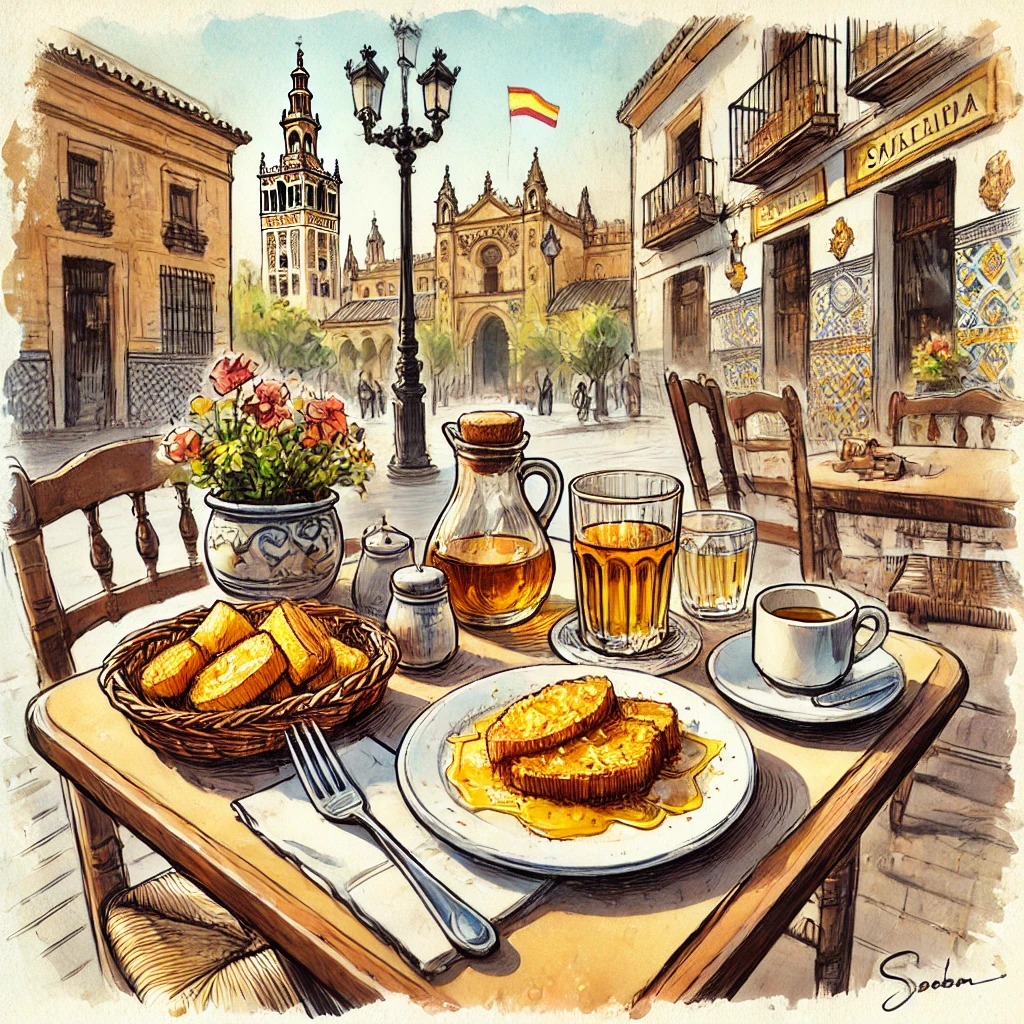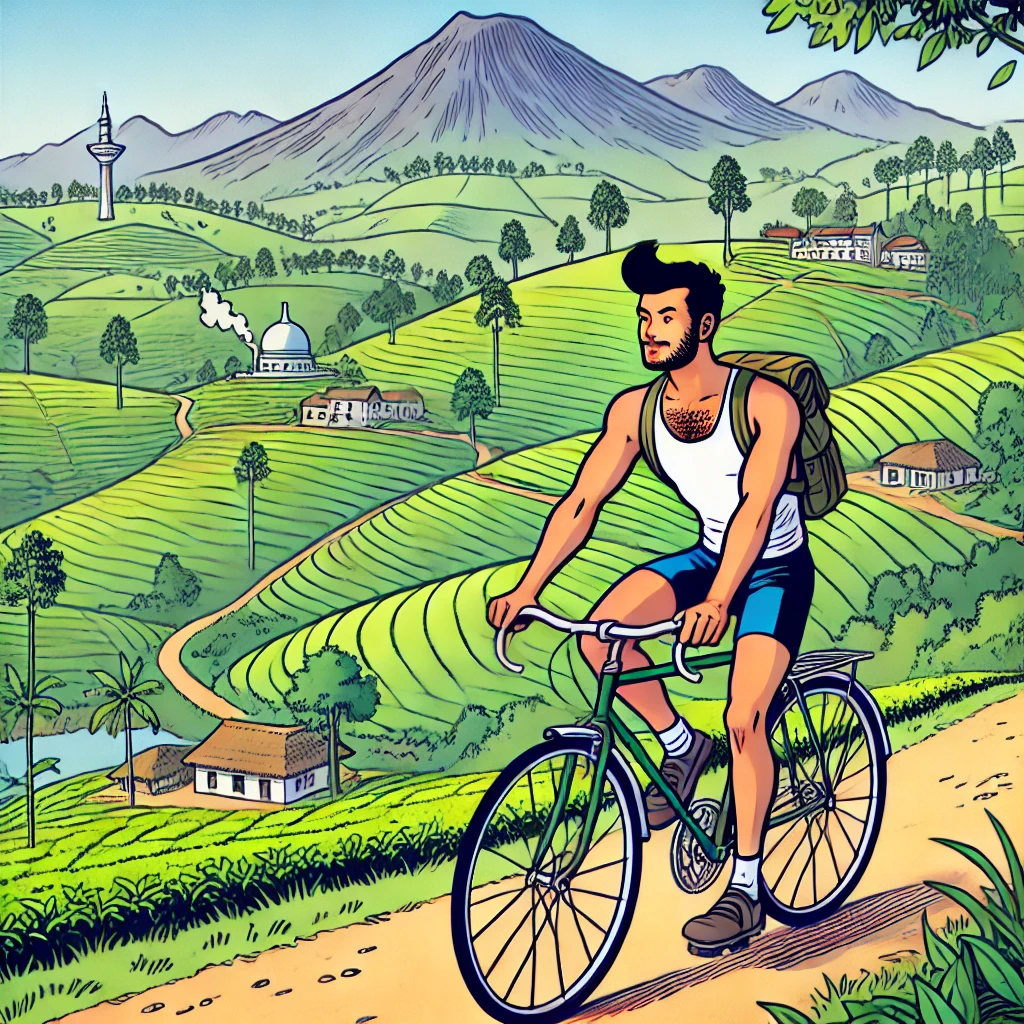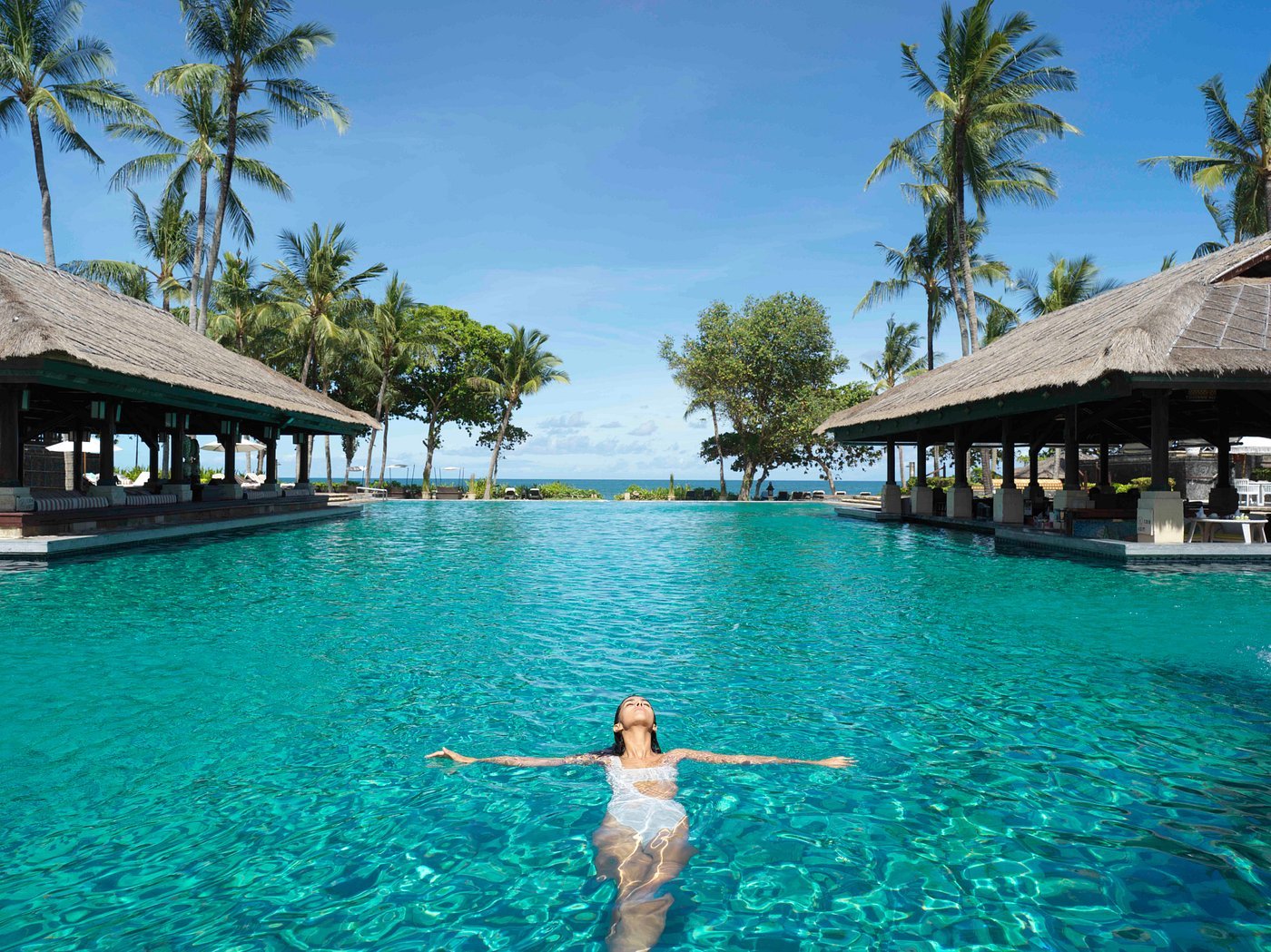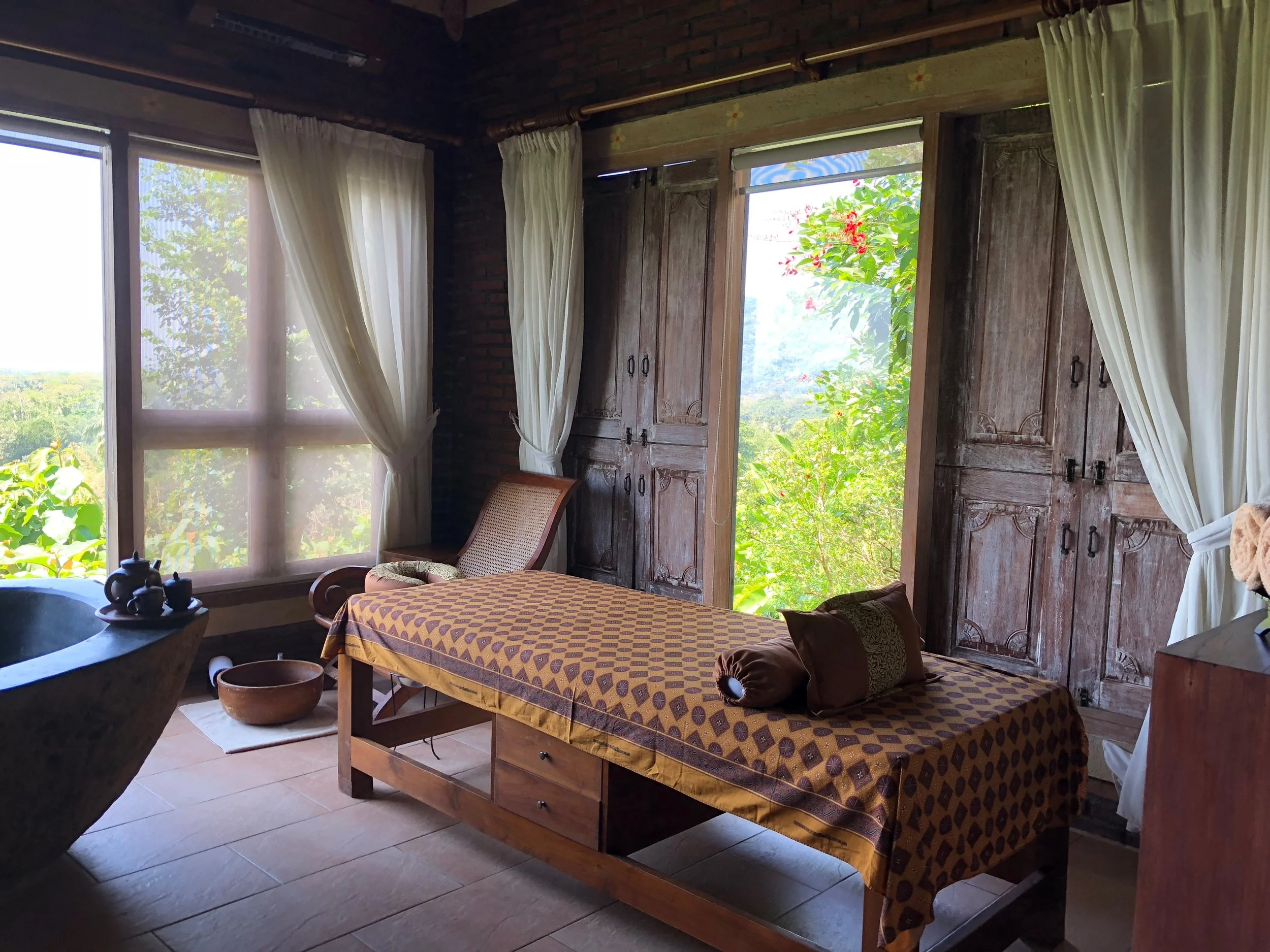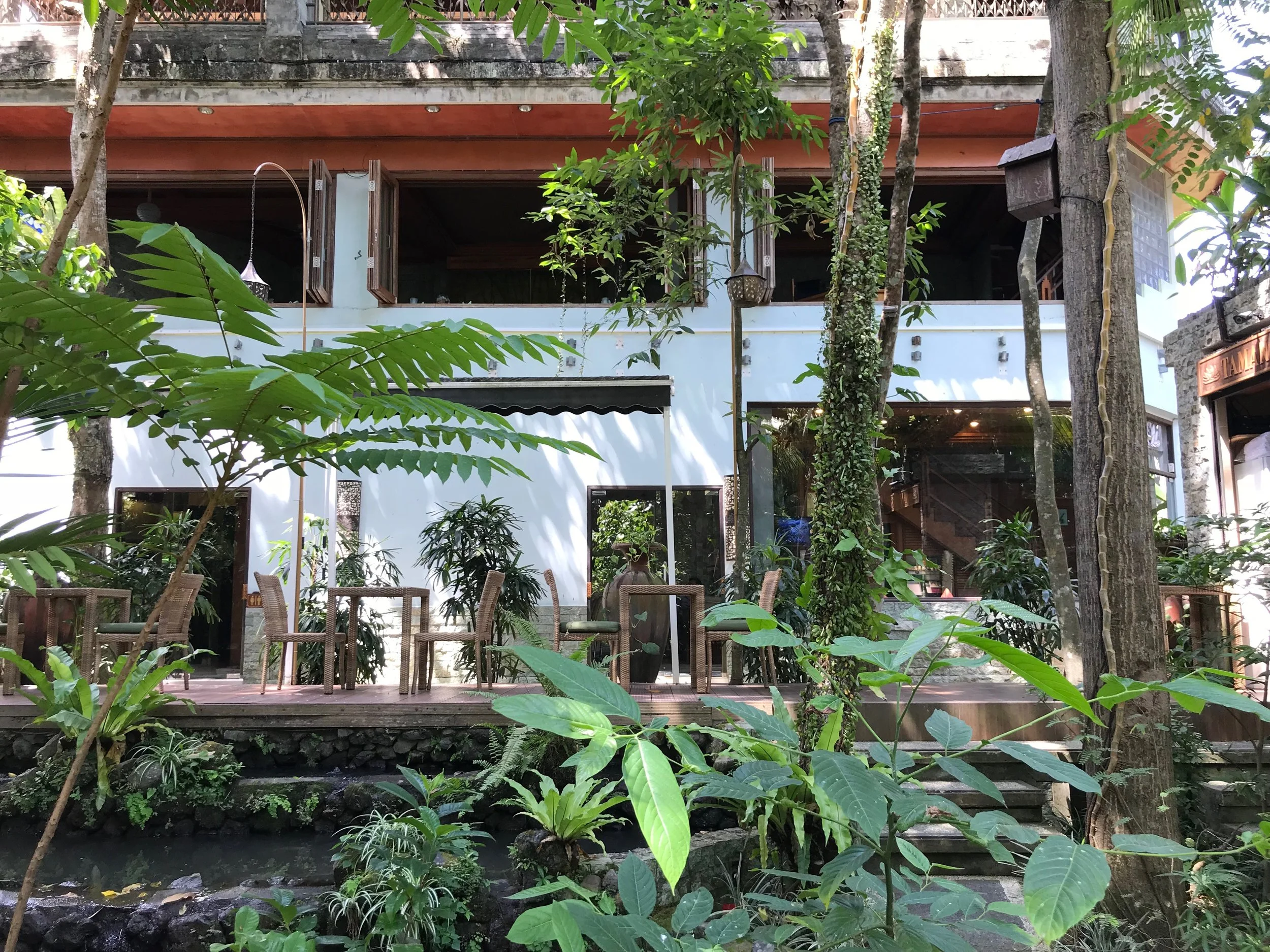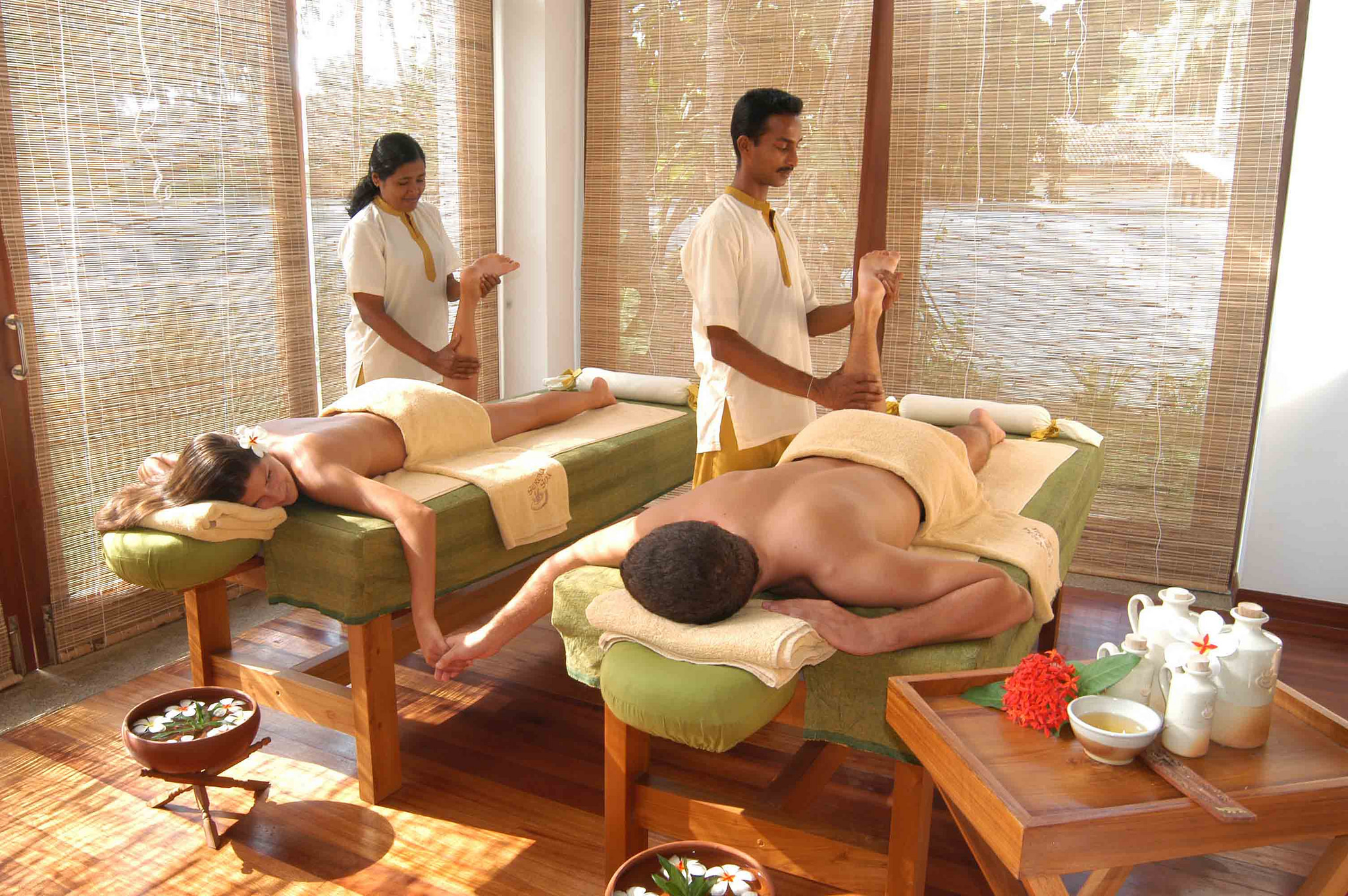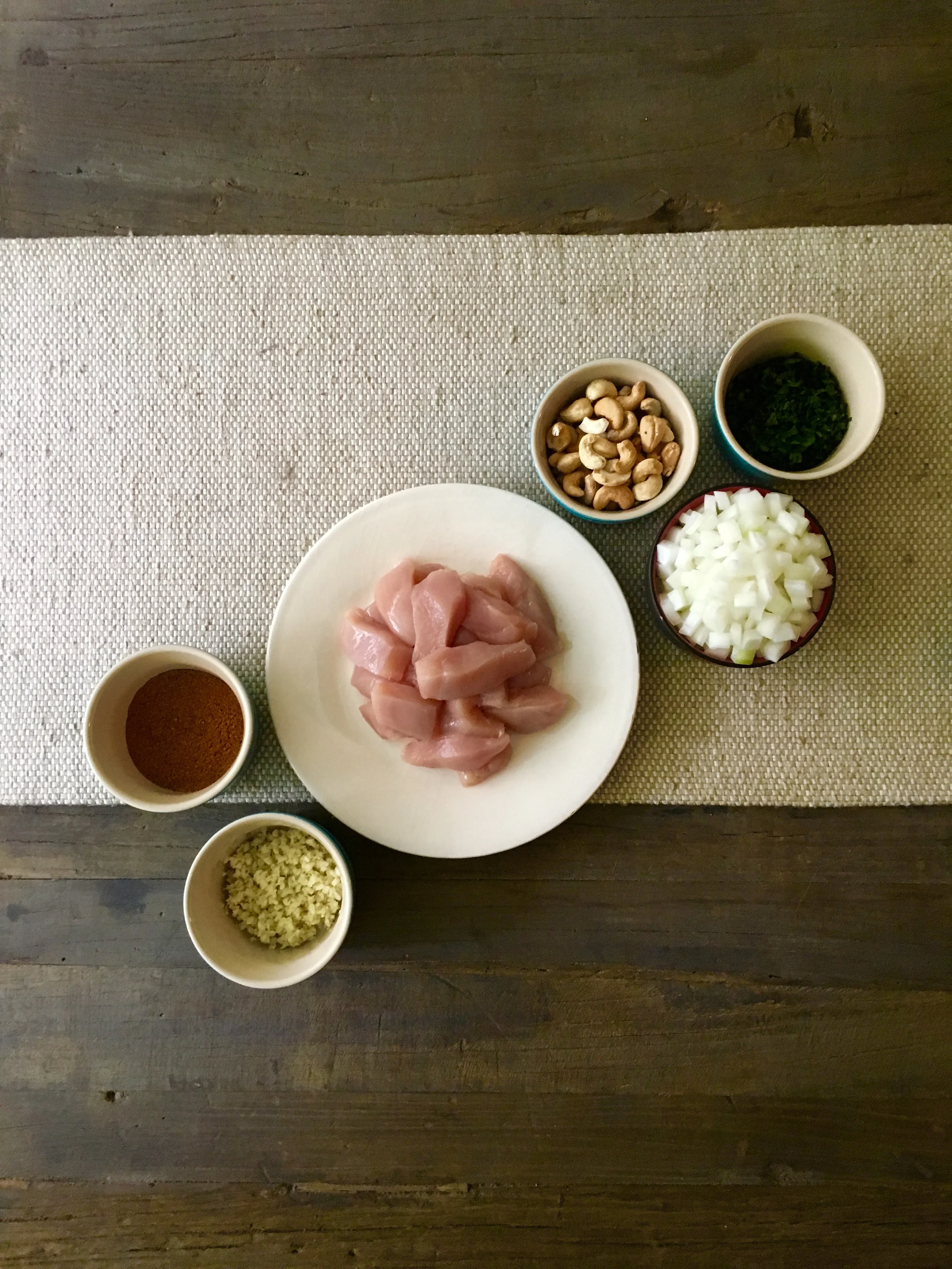Visiting Angkor Wat? Be sure to book a tour of this unique town on Tonlé Sap lake. You can’t miss this water-based way of life.
The floating village of Kompong Kleang, outside of Siem Reap, Cambodia
What I remember most are the children.
They had eyes wide with sorrow, though some squinted in laughter as they followed us around.
“In Kompong Khleang, if you want to go anywhere, you have to get into a boat. That sense of isolation must feel oppressive.”
A little girl from the floating village in her school uniform
You’d think I’d mostly remember the village itself, its small houses built on stilts in the middle of the lake. And yes, it’s a village unlike any other. Even in Venice there are narrow lanes to walk along. In Kompong Khleang, if you want to go anywhere, you have to get into a boat. That sense of isolation must feel oppressive.
Perhaps that’s part of the sadness I saw reflected in the children’s eyes. Poverty is one thing. Not being able to leave your home to play whenever you want is another.
There are a few islands and makeshift transport vehicles as part of the village
There’s a sadness in many of the children’s eyes
Whatever Floats Your Boat
Apparently there are a few so-called floating villages you can visit as an easy day trip from Siem Reap, Cambodia, the base for Angkor Wat exploration. We left ourselves in the very capable hands of our guide, a tall, thin, kind man named Kimsan, who took us to Kompong Khleang.
I’m not sure who thought it would be a good idea to build a village in the middle of Tonlé Sap (which means Great Lake), the largest freshwater lake in Southeast Asia. It’s fed by the Mekong River, which causes it to grow and shrink with the seasons. There can be a difference in depth throughout the year that varies from 10 to 30 feet! When we visited, the houses were a bit over water level; other times of the year, they stand much higher above the lake on their wooden stilts.
We drove to Kompong Khleang one morning, about a two-hour ride. I could probably explore the crumbling structures of Angkor Wat every day of my life, but this is a nice way to break up a week of temple treks.
As we neared the boat launch where we’d get into a vessel to float through town, the paved road ended. The truck slowed to a crawl. Every pothole and divot sent the passengers sailing upward into the ceiling.
“We call these dancing roads,” Kimsan told us.
Cambodians are quick to smile — admirable and inspiring, given all they’ve been through in recent years
That positive spin is typical of the Cambodian outlook on life. By all rights, they should be a demoralized nation, painfully recovering from the genocide their ruthless leader Pol Pot carried out on his own people. Everywhere you go, you’ll pass beggars who are missing limbs, most of which were blown off by the landmines that once dotted the landscape in frighteningly high numbers.
Despite the unfathomable psychic and physical battering they’ve suffered, Cambodians are some of the friendliest people you will meet. They’re quick with a smile. They’re thankful they have survived, and they’re eager to move on to better things.
Before the paved road, when the journey took place along dancing roads, heading to Kompong Khleang took hours longer and could consume an entire day.
Now you can pay a visit to observe this one-of-a-kind way of life — and be back wandering a temple in the jungle that afternoon.
One of the tourboats you’ll ride in to explore the floating village
We all piled into a tourboat and began cruising through the village. It’s home to about 6,000 people, which means it’s surprisingly large. The boat traveled along a few “lanes” lined with small homes built on stilts. Farther along, we saw some houses that actually did float, houseboats of a sort, and these relocate when the water drops, creating a mobile village out in the middle of Tonlé Sap.
The main temple of Kompong Khleang
Kids will follow you as you tour the islands, racing to the water’s edge to wish you a farewell
The telltale bright orange saffron-dyed robes of Buddhist monks is always a pleasant sight
Three boys greet us on the grounds of the Buddhist monastary
We stopped at a couple of islands, which were home to a Buddhist temple, with quiet male monks milling about in their saffron robes beneath the rainbow hues of fluttering prayer flags. On another, we visited a school, stopping into the bare-bones classroom — hardly any books, pieces of paper or writing utensils could be seen. The children were lined up in rows, sitting closely together, all dressed in their adorable blue and white uniforms.
Monks teach classes at the local school in Kompong Khleang
A classroom we toured — but where are all the books and paper?
Schoolboys on a break from classes
Most of the kids wore a school uniform but no shoes
The Fake Floating Villages
We lucked out by having such an awesome tour guide for the week. Kimsan took us to Kompong Khleang without any sort of discussion. Since our trip, I’ve learned about two other floating villages that are closer to Siem Reap, one of which is a total scam and one of which sounds OK but is a bit of a ripoff: Chong Kneas and Kompong Phluk.
“Chong Kneas features absurdities such as small kids sporting huge water snakes and so-called crocodiles farms which in reality are small ponds where dozens of crocodiles are crammed together,” writes Triple A Adventures Cambodia, a tour company. “At some point, your boat will probably also stop by a ‘local shop’ where it’ll be ‘strongly suggested’ that you buy $60 rice bags ‘for the children.’
“Last but not least, the locals do not get much from the money you’ll spend as the boat service, which is what you’re paying an entrance fee for ($30/person), is managed by a private company,” they continue. “As most visitors there come from Korea, the aforementioned company kindly built floating ‘local’ restaurants that serve Korean food in case their main customers miss it.”
And here’s Triple A Adventures’ review of the other village, Kompong Phluk: “You won’t see any croco farms or children with snakes there, and the boat journey is actually quite scenic and enjoyable. Despite the growing flow of tourists (you’ll understand what we mean when you see the dozens of boats at the dock), Kompong Phluk has kept a lot of its authenticity and its visit is overall a nice experience.
“Kompong Phluk is a small village, so the boat ride is consequently quite short. Some find it too short compared to the $20 entry fee per person. Moreover, the boat service is managed by a private company, which means that the locals don’t really see much of the money generated from tourism.
Overall, Kompong Phluk is still a good option if you only have a few hours to spend.”
Getting into a boat every time you want to go anywhere is the way of life in Kompong Khleang
This fiesty little firecracker was our favorite villager. She was so full of life and followed us all over the island
In Kompong Khleang, sometimes the market comes to you
Wally likes to joke that this is the town hottie
Lake Town
No trip to Angkor Wat is complete without a daytrip to a floating village, and it seems as if there’s no reason to go anywhere but Kompong Khleang. As you head through the canals, you’ll literally be able to see inside these people’s lives, catching glimpses into their humble homes, many of which are open and exposed. You’ll see narrow canoe-like boats piloted by children who can’t be much older than 6.
We hope you enjoyed your tour of Kompong Khleang!
It’s quite an adventure — one that will open your mind, put things in perspective. You’ll develop a newfound appreciation for all the conveniences you have in your life. That’s one of the most profound things travel can do. –Wally
“Despite the unfathomable psychic and physical battering they’ve suffered, Cambodians are some of the friendliest people you will meet. ”

